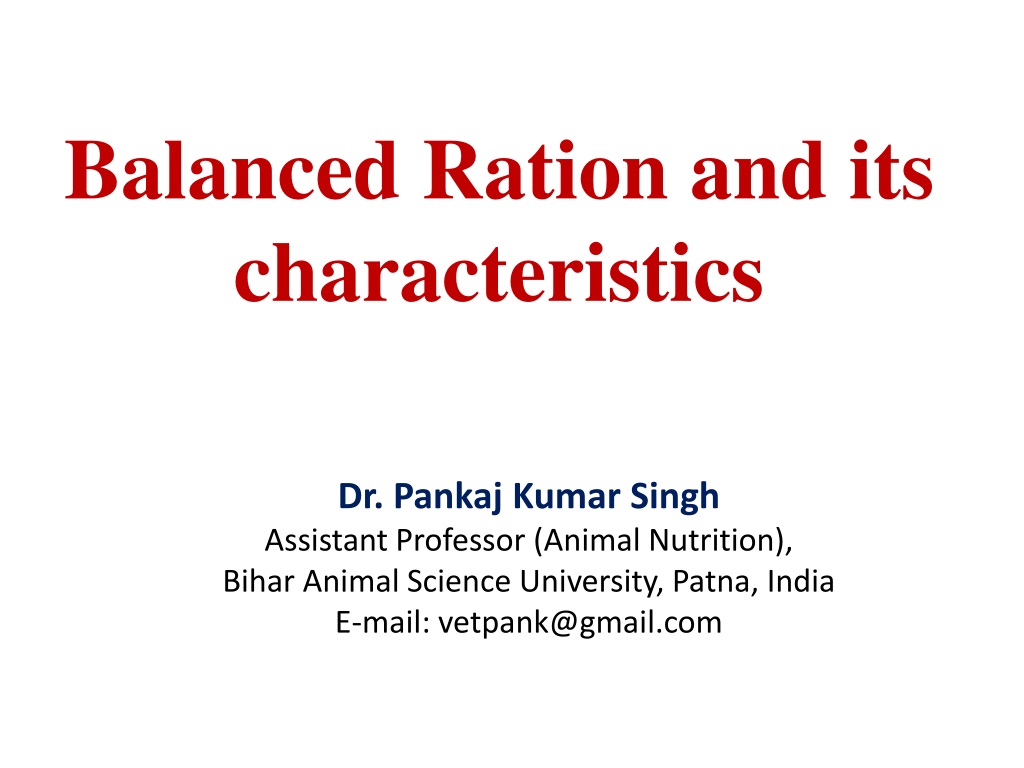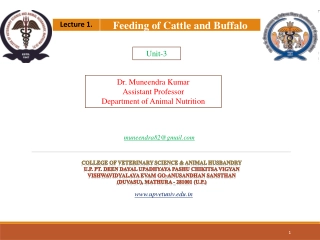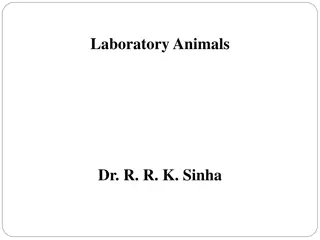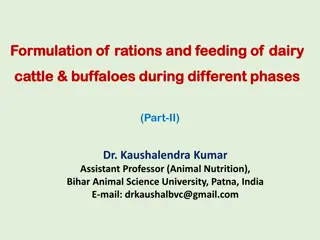Characteristics of a Balanced Ration for Animals
A balanced ration is crucial for providing essential nutrients in the right amounts to animals for proper nourishment and physiological functions throughout the day. It should be properly balanced, palatable, have a variety of feed ingredients, and contain adequate mineral matter to ensure optimal health and productivity of livestock. Improperly balanced rations can lead to wastage of feed and lower milk production.
Download Presentation

Please find below an Image/Link to download the presentation.
The content on the website is provided AS IS for your information and personal use only. It may not be sold, licensed, or shared on other websites without obtaining consent from the author.If you encounter any issues during the download, it is possible that the publisher has removed the file from their server.
You are allowed to download the files provided on this website for personal or commercial use, subject to the condition that they are used lawfully. All files are the property of their respective owners.
The content on the website is provided AS IS for your information and personal use only. It may not be sold, licensed, or shared on other websites without obtaining consent from the author.
E N D
Presentation Transcript
Balanced Ration and its characteristics Dr. Pankaj Kumar Singh Assistant Professor (Animal Nutrition), Bihar Animal Science University, Patna, India E-mail: vetpank@gmail.com
Ration A ration is the feed allowed for a given animal during a day of 24 hours. The feed may be given at a time or in portions at intervals. Balanced ration A balanced ration is a ration, which provides the essential nutrients to the animal in such proportion and amounts that are required for the proper nourishment of the particular animal for 24 hours for various physiological functions.
The ration should be properly balanced With a correct and balanced ration, livestock can get the best out of all the constituents present in feed resulting in production of milk at cheaper cost. Improperly balanced ration ~ much of the feed is wasted. Because the feed digested alone goes for milk production and maintenance of the body. A balanced ration is thus more purposeful and beneficial.
The ration must be palatable Whatever feed given to an animal must be to its liking. Evil smelling, mouldy, musty, spoiled and inferior feeds are unpalatable and must not be given to the animals. If some excellent feed is not good in taste, they should be improved by special preparations like addition of salt or other feed additives.
Variety of feed ingredients in the ration By combining many feeds in a ration, a better and balanced mixture of proteins, vitamins and other nutrients are furnished than by depending on only a few. Variety of feeds in the ration makes it more palatable. This provides variety of nutrients supply to make a ration balanced
The ration should contain adequte of mineral matter Every litre of milk yielded by a cow contains a little more than 0.7% of mineral matter. If the amount of mineral matter in the ration is not sufficient to meet the demand in the milk yield, the cow shall have to draw upon her own body supplies or fall down in milk yield. At the end of her lactation, the cow will be left as an extremely weak animal and her milk yield in subsequent lactation will go down considerably.
Sufficient green fodder Green succulent fodders are of great importance in feeding of milch animals They aid in the appetite and keep the animal in good condition. Green fodders are bulky, easily digestible, laxative and contain enough of necessary vitamins. Leguminous green fodders are very rich in proteins.
The ration should be fairly bulky The stomach of cattle is very capacious and they do not feel satisfied unless their bellies are properly filled up. Indigestible fibre is not of any great nutritional importance but it plays an important role in giving a feeling of fullness to cattle. If the bulk of the ration supplied is small, cattle may fall a victim to the depraved habits of eating earth, rags, dirty refuses, etc., for filling up stomachs.
The ration must be properly prepared: The feed must be well prepared Some feeds require special preparations before administration in order to render them more digestible and palatable. Hard grains like gram, barley, wheat, maize, etc., should be ground before feeding so that their mastication may become easy. Coarse fodders like dry jowar, bajra and green fodders of these crops should be chaffed before feeding. Some dry fodders, such as bhusa of cereals and legumes should be moistened. Soaking of feeds like various types of cakes and cottonseed soften them and makes them more palatable.
The ration should be fairly laxative Constipation is often the cause of most of the digestive troubles. It is, therefore, necessary to give such feeds, which are laxative (inducing bowel movement) in character.
Maintain regularity in feeding Cattle like other animals are creatures of habits and get so much used to routine that marked changes may lead to restlessness. As the feeding hour approaches, their glandular secretions become active in anticipation of the meal. Irregularity in milking and feeding tells very badly on the productive powers of an animal. The time of feeding should be evenly distributed so that the animals are not kept too long without feed.
Liberal feeding The animal should be provided in plenty with all the requirements, which are necessary for full milk production and maintenance of her body. There should also be some allowance made for what goes as a waste in preparation and serving the feed to the cow. It should not be mistaken for overfeeding. It is doubly wasteful because it wastes feed and it also injures the animal s system.
Individual feeding In order to obtain maximum profits, cows must be fed individually according to the production and requirements instead of allowing the same ration to each animal in the herd. Individual feeding ensures adequate supply of nutrients to livestock
Avoid sudden changes in the ration Sudden changes are often the cause of many digestive troubles, the more notable being Tympanitis , Impaction etc. All changes of the feed must be gradual and slow. An animal system receiving a certain feed or a mixture of feeds gets accustomed to it. It gets upset by sudden changes. .
A ration should not be too bulky If the ration is too bulky, the animal will fail to get all its nutrient requirements. Economy in labour and cost The ultimate object of rearing animals is to make profits. The cost of the feeds and the labour in feeding should be minimised to an extent that economic efficiency is not affected.
Tips for feeding dairy cattle Concentrate must be fed individually according to production. Good quality roughage saves concentrates. 20 kg grass or 6-8 kg legume fodder =1 kg concentrate mixture. Regularity in feeding should be followed. Feed Concentrate mixture before milking half in the morning and the other half in the evening. Feed the roughage after milking and watering. High yielding animals may be fed three times a day . Increasing the frequency of concentrate feeding will help to maintain normal rumen motility and optimum milk fat levels. 17
Tips for feeding dairy cattle Abrupt change in the feed should be avoided. Over feeding conc. may result in off feed & indigestion. Grains should be ground to medium degree of fineness. Long and thick-stemmed may be chopped. Mix Legume fodders with straw to prevent bloat. Silage and other feeds, which may impart flavour to milk, may be fed after milking. Concentrate mixture in the form of mash may be moistened with water and fed immediately. Pellets can be fed as such. Optimum roughage : concentrate ratio should be 40:60 for high yielders 18



























